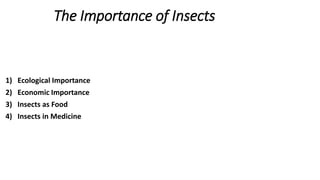The importance of insects the importance of insects in
•Download as PPTX, PDF•
3 likes•5,029 views
Ecological Importance Insect as a Food Insect as a Medicine Sericulture
Report
Share
Report
Share

Recommended
Recommended
More Related Content
What's hot
What's hot (20)
Insect wing, their modifications and wing coupling mechanism

Insect wing, their modifications and wing coupling mechanism
Insect Antennae: Structure, Functions and Their Modifications

Insect Antennae: Structure, Functions and Their Modifications
Apiculture: introduction, species types and different methods of rearing of bees

Apiculture: introduction, species types and different methods of rearing of bees
Similar to The importance of insects the importance of insects in
Similar to The importance of insects the importance of insects in (20)
L-1&2 Economic classification of insects and Pests Surveillance.pptx

L-1&2 Economic classification of insects and Pests Surveillance.pptx
Plant Biodiversity Enhances Bees and Other Pollinators in Agro Ecosystems.pptx

Plant Biodiversity Enhances Bees and Other Pollinators in Agro Ecosystems.pptx
Dipteran insects and their positive role in environment.The word D.pdf

Dipteran insects and their positive role in environment.The word D.pdf
Evolution of Resource Harvesting Organs with Resilience of Insects and Role o...

Evolution of Resource Harvesting Organs with Resilience of Insects and Role o...
Recently uploaded
Recently uploaded (20)
GBSN - Microbiology (Unit 3)Defense Mechanism of the body 

GBSN - Microbiology (Unit 3)Defense Mechanism of the body
Genome Projects : Human, Rice,Wheat,E coli and Arabidopsis.

Genome Projects : Human, Rice,Wheat,E coli and Arabidopsis.
Site specific recombination and transposition.........pdf

Site specific recombination and transposition.........pdf
Human & Veterinary Respiratory Physilogy_DR.E.Muralinath_Associate Professor....

Human & Veterinary Respiratory Physilogy_DR.E.Muralinath_Associate Professor....
Thyroid Physiology_Dr.E. Muralinath_ Associate Professor

Thyroid Physiology_Dr.E. Muralinath_ Associate Professor
Cyathodium bryophyte: morphology, anatomy, reproduction etc.

Cyathodium bryophyte: morphology, anatomy, reproduction etc.
GBSN - Biochemistry (Unit 2) Basic concept of organic chemistry 

GBSN - Biochemistry (Unit 2) Basic concept of organic chemistry
TransientOffsetin14CAftertheCarringtonEventRecordedbyPolarTreeRings

TransientOffsetin14CAftertheCarringtonEventRecordedbyPolarTreeRings
POGONATUM : morphology, anatomy, reproduction etc.

POGONATUM : morphology, anatomy, reproduction etc.
Cot curve, melting temperature, unique and repetitive DNA

Cot curve, melting temperature, unique and repetitive DNA
Selaginella: features, morphology ,anatomy and reproduction.

Selaginella: features, morphology ,anatomy and reproduction.
Daily Lesson Log in Science 9 Fourth Quarter Physics

Daily Lesson Log in Science 9 Fourth Quarter Physics
Module for Grade 9 for Asynchronous/Distance learning

Module for Grade 9 for Asynchronous/Distance learning
The importance of insects the importance of insects in
- 1. The Importance of Insects 1) Ecological Importance 2) Economic Importance 3) Insects as Food 4) Insects in Medicine
- 2. Ecological Importance • Decomposers. By recycling of dung, dead wood material insects stimulate and accelerate breakdown of organic materials by such organisms as soil mites, fungi and bacteria, enhancing soil fertility, reducing potential spread of diseases, and increasing site utility. Borrowing insects mix organic and inorganic material, increasing soil porosity and water-holding capacity. Example: termites (Isoptera) and cockroaches (Blattodea) There are Different major ecosystem services provided by insects:
- 3. • Pollinators Many plants depend on insects as pollinators of their flowers, and pollinators can be a limiting resource for them honey bees lepidopterans
- 4. • Dispersal agents Insects disperse seeds, transmit pathogenic agents, and even transport other invertebrates from place to place (the phenomenon known as phoresy). Ants are amongst the most important seed dispersers.
- 5. • Economic Importance Insects have tremendous economic importance. Some insects produce useful substances, such as honey, wax, lacquer, and silk Adult insects, such as crickets, as well as insect larvae, are also commonly used as fishing bait
- 6. Insects as Food Insects, of course, are not just eaten by people. Insects are the sole food source for many amphibians, reptiles, birds, and mammals, making their roles in food chains and food webs extremely important In some parts of the world, insects are used for food by humans. Insects are a rich source of protein, vitamins, and minerals, . Among the most popular are cicadas, locusts, mantises, grubs, caterpillars, crickets, ants, and wasps
- 7. Insects in Medicine Insects have also been used in medicine. In the past, fly larvae (maggots) were used to treat wounds to prevent or stop gangrene
- 8. Summary 1. In the environment, some insects pollinate flowering plants. 2. Insects produce useful substances, such as honey, wax, lacquer, and silk. 3. Insects are food sources in some parts of the world.
